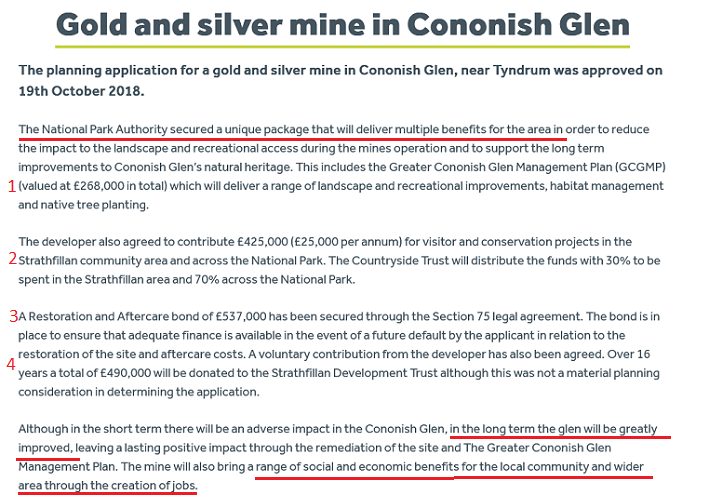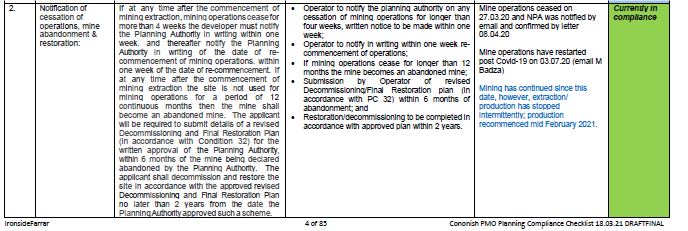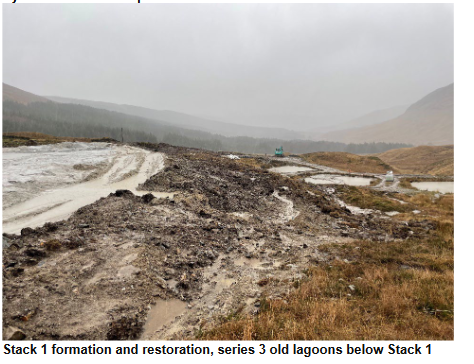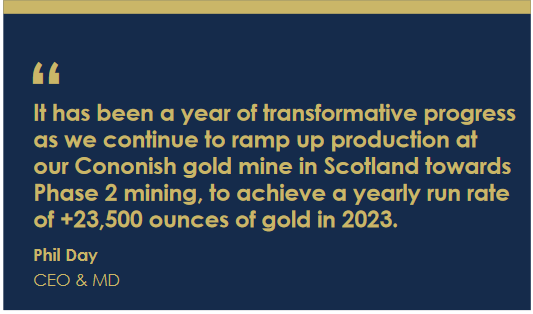
Eighty staff laid off
Last week Scotgold Resources announced that the “unique package” which the Loch Lomond and Trossachs National Park Authority (LLTNPA) had claimed would “deliver multiple benefits for the area” and create jobs (see above) was putting the majority of its employees at the Cononish goldmine in Strath Fillan on short-term unpaid leave (see here).
Doing this appears to be legal only where there are clauses in a person’s contract of employment allowing for unpaid leave (see here). In such cases the person might be entitled to five days statutory lay-off pay (£31 a day). By putting staff on unpaid leave Scotgold’s subsidiary which employs them, SGZ Cononish Ltd, has prevented the workforce seeking redundancy for four weeks. This effectively leaves the workforce with very little or no income for this period. That says something about the quality of the jobs brought to Strath Fillan by the LLTNPA’s decision to approve the goldmine.
One of the main reasons the LLTNPA made a U-turn and decided to support the goldmine (it had initially opposed it as a matter of principle) was the political pressure to create local jobs. The question of how many residents of the National Park have been employed by the mine has never been answered by the LLTNPA. Scotgold’s annual report for 2022 reveals that of the 96 people then employed by the mine, just 51 were from Scotland. With very little accommodation locally, it appears most employees will have had to travel a significant way from home – with all the costs that involves – to find insecure employment. The question of what employment benefits have been brought to the area by Scotgold is a question which deserves proper research.
Last week Scotgold also claimed it was in negotiations to secure funding to retain some key staff at the mine. The implication is that immediately following their announcement there was no-one on site to respond to an emergency. This exposes a major hole in the conditions that formed part of the planning consent granted by the LLTNPA:

Those conditions contain no provisions for emergency cover should the mine cease operating. The only legal requirement on SGZ Cononish is to formally notify the LLTNPA should mining cease for 28 days. The restoration plan, which is financed through a bond, only kicks in after a year.
An important environmental question therefore is what happens to the spoil heaps/stacks in the intervening period? What happens, for example, if there is a period of intense rainfall and the water starts washing out the mine waste?

Who would be responsible for responding to such an emergency and who would pay for the clear up? If the LLTNPA and our other public authorities have plans to deal with such such a situation they are secret.
The predictable and evolving financial crisis
Since my post in May (see here) in which I called on our public agencies to act, there have been several indications that SGZ’s financial position was deteriorating further and therefore that the need to address the environment risks posed by the mine shutting down was becoming ever more urgent:
- On 1st June Scotgold announced the resignation of the goldmine’s Chief Executive, Philip Day (see here). Mr Day had been brought in in March 2022 to replace Richie Gray, who had been in post since 2014. No smoke without fire! Just six months earlier Mr Day had reported that:

In fact between January and March production dropped to a new low.
- On 16th August SGZ Cononish’s unaudited and abbreviated accounts for the year to June 2022, which had been due on 31st March 2023, were published on the Companies House website (see here). During the financial year the total liabilities of the company had increased from £36,762,964 to £43,402,146. Many of the assets recorded on the balance sheet as offsetting these liabilities were intangible and dependant on the mine producing gold in much greater quantities than it has to date. Even so net liabilities increased by almost £5m. Despite all this accounts reported that in the opinion of the two directors the company was “a going concern”.
- On 11th September, barely four weeks later, Scotgold announced that they had suspended dealing in shares (see here). That wouldn’t have happened if the company was a going concern and raises serious questions about the claims made by the two Directors in the accounts.
It appears, however, that investors have now finally seen through the spin about the prospects for the mine which has been going on now for almost 20 years, burning many wallets on the way. On 11th September Scotgold had claimed negotiations with new investors were at an advanced stage. Three days ago, on 3rd October, Scotgold reported to the London Stock Exchange Alternative Investment Market that its “most advanced prospective investor” had walked away and it was likely to enter administration.
The LLTNPA’s response to the crisis
Back in April, when describing the financial crisis at the gold mine (see here), I highlighted the fact that LLTNPA officers had in November 2022 identified that the bonds they had secured from SGZ Cononish Ltd were inadequate. These covered the restoration of the mine (£567k – point 3 on screenshot above) and the Greater Cononish Glen Management Plan (GCGMP) (£268k – point 1 on screenshot). The bond amounts had not been uprated since 2017 and this left the LLTNPA very exposed should the mine cease operations, particularly with the rampant inflation of the last two years..
The LLTNPA refused to answer my initial information request about the progress that had been made in re-negotiating these bonds on the grounds that this might affect the commercial interests of Scotgold and affect negotiations. When I challenged this – the LLTNPA should not have put private interests before the public interest – they eventually released eight documents on 30th June. This included emails (see here) which suggest the revised amount of the restoration bond had been increased to £623,767.46 around 31st March, so the claim that releasing the information might have affected negotiations appears to have been without foundation. In April the LLTNPA published their initial refusal to my information requests (see here) but interesting they have not made public the information they released on 30th June (its available from me on request).
The emails show the Director of Planning, Stuart Mearns ( whom I have often criticised in the past) in a good light. It was he who initiated the Bond Review in May 2022, at a time when everything appeared hunky dory and Scotgold was talking about opening up more gold mines across the Highlands, and he also pushed for the review of the bonds to be concluded within 3 months. It took ten months for the Restoration bond to be revised and the review of the GCGMP bond was still to be completed at the end of March. One of the major issues revealed by the emails is that it appears that it was Dalgleish Associates, acting on behalf of SGZ Cononish, who provided most of the figures for the review of the restoration bond (a conflict of interest surely?). Ironside Farrar acting on behalf of the LLTNPA then used those figures to calculate the revised bond amount.
Whether the revised bond amount will be sufficient to restore the mine should it close permanently remains to be seen. Meantime the pressing question is what arrangements have been put in place to protect the natural environment while the workforce has been laid off?
The answer appears to be nothing. The Cononish goldmine has not appeared on the agendas of the main board, the planning committee or the risk and governance sub-committee this year. There was no meeting of the planning committee between 24th April and 25th September when minutes of the earlier meeting were published (see here). They record that under AOB “CC [Claire Chapman, Convener] + SM [Stuart Mearns Director of Place] gave Members a verbal update on ScotGold, operators of the Cononish Gold Mine.” There is no record of what was said or if Committee members expressed any concerns and no actionswere agreed.
It is possible that the situation at the Cononish mine was discussed by the Risk and Audit Committee, which does meet every three months. However, all discussions about corporate risks and the corporate risk register now take place in secret. We don’t know therefore whether the LLTNPA have any concerns about whether the collapse of the mine could risk the reputation of the National Park let alone what financial liabilities they believe they might face (the public sector always ends of picking up the tab when it comes to mine restoration).
LLTNPA staff, however, are still also actively trying to cover-up what is happening on site. They have thwarted my attempts to challenge their policy of only publishing the mine monitoring reports six months late by drawing out the FOI process for six months. However, in order to prevent an appeal to the Information Commissioner in their review of my Information Request dated 30th June they did commit that “The report from the site visit of 13th March will be published on 13th September 2023.”
That was a lie. Its still not been published on the planning portal (see here):

Why not? Given the staff lay-offs, the LLTNPA’s argument that monitoring reports should be kept confidential for six months to allow them to negotiate actions with SGZ Cononish has collapsed.
The implications of the gold mine going into administration
The fact that it now appears inevitable that SGZ Cononish Ltd will go into administration does not mean that the goldmine is now finished. The job of an administrator is to try and turn a company around and if not, sell off its assets. The lure of gold is such that it is likely a buyer will be found for the Cononish mine if the price is low enough (that is very unlikely to be anywhere near the value of the £18,872,068 reported in the accounts).
Any prospective purchaser, however, will require access to significant working capital and is likely to want to reduce running costs to a minimum. While that should not affect the bonds that have already been paid for, it could potentially affect other “community benefits” and more importantly the various measures which are in place to reduce environmental risks .
The prime “benefit” at risk would appear to be the £25k a year (point 2 on screenshot above) which SGZ Cononish has been paying to the Loch Lomond and Trossachs Countryside Trust, an organisation based at the LLTNPA’s headquarters and controlled by them. That still stinks.
By contrast the £490k community benefit thatthe LLTNPA trumpeted would be paid to the local community in Strathfillan (point 4 in screenshot above) was never worth the paper it was written on. Note 23 in Scotgold’s accounts explains why:
“A donations agreement with the Strathfillan Community Development Trust (”SCDT”) was
concluded on 7 September 2018 pursuant to which £240,000 is payable to SCDT in annual
instalments of £15,000 per annum upon the Cononish mine reaching an ore processing
rate of 3,000 tonnes per month (“tpm”), increasing to £30,000 per annum in any year upon
reaching an ore processing rate of 6,000tpm. The donations agreement further provides for the
payment of two lump sum payments of £125,000, the first being payable on the first anniversary
of commencement of commercial production at the Cononish mine at a rate of at least
3,000 tonnes per month, and the second lump sum being payable on the earlier of the date falling
four years after the payment of the first lump sum of £125,000 and the date of commencement of
production at an ore processing rate of 6,000tpm, whichever is the earlier. The ore processing rate
of 3,000 tonnes per month was achieved during the year to 30 June 2022″.
With the Cononish Mine having reached a production rate of 3,000 tonnes of ore during the last financial year, the Community Development Trust was due a first payment of £15k. Whether this has been paid is another question. The last accounts published by the SCDT on their website are for the year 2019-20 (and show no income from the mine or from the Loch Lomond and Trossachs Community Trust). Even if a new owner respects the commitment asset out in Scotgold’s accounts, the SCDT will receive nothing like the £490k still claimed by the LLTNPA.
These community benefits, used to buy support for the mine going ahead, were always slight compared to the potential destruction caused by the mine. But the local community and wider public which care about the natural environment now faces the prospect of potential new owners demanding a relaxation in other planning conditions in order to save jobs and keep the mine open. Given their past record, one can see the LLTNPA buckling without enormous political pressure.
What needs to happen?
In order to address the immediate environmental risks at the mine, a number of actions are required:
1) Lorna Slater, the Minister responsible for National Parks, should instruct LLTNPA Board Members that they have a responsibility to respond to what is happening at the goldmine and put proper contingency arrangements in place in partnership with other public agencies to address the risks created by the SGZ Cononish laying off its workforce and going into administration.
2) Lorna Slater should also tell LLTNPA Board Members that there should be no relaxation in the planning conditions which currently cover the mine. If a prospective new operator cannot make the mine viable under existing arrangements, the mine should close permanently.
3) All outstanding monitoring reports for the goldmine should be published immediately. Unless and until there is a fully functioning workforce back on the mine site, the LLTNPA should be undertaking weekly monitoring visits to the site with appropriately qualified staff. When high levels of rain are forecast (the Rest and Be Thankful has just been closed again for three days) these visits should be undertaken on a daily basis.
4) The LLTNPA should publish any records of meetings that have secretly discussed the crisis goldmine and also make its Risk Register public. That would help ensure LLTNPA board members and senior management are held to account.
5) The environmental organisations and those who opposed the mine (that includes the Scottish Campaign for National Parks and the Friends of Loch Lomond and Trossachs) need to get together and put pressure on both the Scottish Government and the LLTNPA to take appropriate action.

Aye, so why are such industrial activities allowed in a national park in the first place?—because it’s not a real national park in the first place.
Given the rainfall today, Saturday, I shudder to think what kind of mess the site is in. Once again the desire to keep happy overseas investors rather than protect a national park creates an almighty mess when the profits don’t roll in. Another bloody disgrace in our so called ‘national parks’.
As a member of green party Scotland and residing in Dunbartonshire I fully anticipate that Lorna Slater do the right thing.
Gold mining is one of the most polluting activities on earth as I have explained on this blog and it would be really helpful if local green party members could get motions up calling on the leadership of the party to take a stand against any new mines in Scotland – that means tackling the Crown Estate who has issued further prospecting licenses to SGZ Cononish’s sister company SGZ Grampian – and for the National Park to do all in its powers to close the mine as soon as possible. The Scottish Government could offer alternative employment to the miners if they went ahead with a tunnel at the Rest and Be Thankful
In 2018 I discussed a pragmatic roadmap for processing ore from the mine with Richard Gray. This was based on my 45 years of global mining experience. He neglected my suggestions and went for lesser experienced plant professionals. The low metal recoveries which plagued the mine, coupled with lower than normal plant availability, were a direct result of this lack of experience. I think that the mine can be rescued but it needs a paradigm shift in the way it operates…lean, mean and with intelligence!